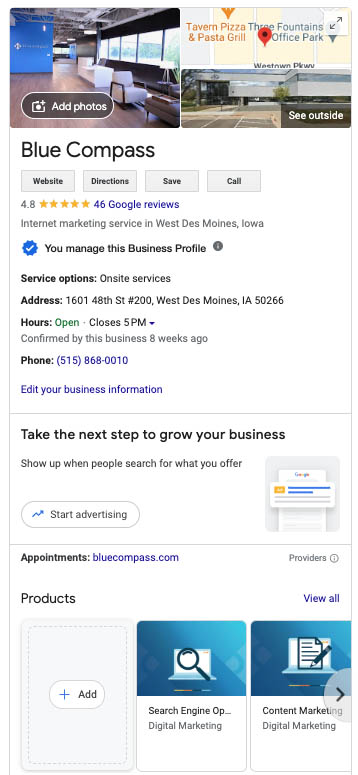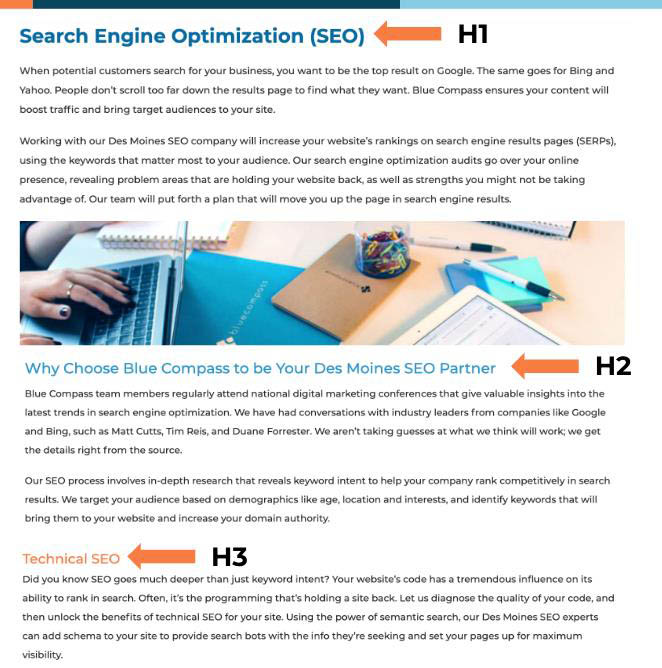August 5, 2024
Katrina Reger
SEOUser ExperienceContent MarketingDigital Marketing
10 Ways To Boost Web Traffic To Your Site
Your website is your best marketing tool. The site provides the opportunity to tell your company’s story and share all the details about your products and services. But the challenge for many marketers is getting people to your site in the first place. And we get it. With all the online competition out there, showing up for top results on search engines can be difficult, but not impossible!
How Do I Get More Traffic To My Website?
In short, you increase web traffic when you follow SEO best practices. This includes steps like SEO keyword research and optimization, correct heading tags, ads, and more. But for clarity and tangible next steps, we’ve created a top ten list to help continually boost web traffic. So without further ado, let’s dive in.
10. Claiming And Optimizing Local Business Listings
One easy way to gain more awareness for your brand is by making sure you have claimed various local business listings. These profiles give quick information about your company when users are doing initial searches, and you can easily highlight a link back to your website. The more you do this and optimize content for SEO like filling out all of the description details, the more chances you have to direct people to your site.
Common Local Business Listings Include:

9. Optimizing Meta Titles & Meta Descriptions
A straightforward way to boost web traffic to each one of your pages is by filling out the meta title and descriptions ( you might be surprised at how many people miss this!).

Every page on your website should have a unique title and description—why? These words quickly tell people what the page is about. Think of them as billboards for your brand in a search engine. Writing one is almost like a creative art form. You want to ensure it appeals to your target audience and uses relevant keywords.
Important side note: if you don’t pick the meta title and description, Google will do that for you. That’s not ideal as you are not the one picking the right keywords and phrases that will align with your content most accurately.
Meta titles shouldn’t be more than 60 characters and the description should be below 120 characters. Just keep in mind how you search on Google—these are the keywords you scan to figure out if you want to visit a page or not, so try and optimize content for SEO value.
8. Speed Up Your Pages’ Load Times
Pages should load quickly. If a page takes five, six, or 20 seconds to load, that is too long! This is a key ranking factor in Google, and they are looking for pages that load quickly, within one to two seconds.
Improving this tactic is more technical, as it is often connected to your code and server connection, along with your core web vitals. If you don’t know, ask your developer for starters. Additionally, you can look to see how many pixels you have on your website. For example, a lot of Facebook or Google ads contain pixels that can slow your site down. You can also examine how big your images are (100 KB or less is best). Compressing your images can make a huge impact on improving your page speed.
7. Gain Backlinks From Other Websites
This might sound simple, but links on other websites truly boost web traffic. Links are another way a person (or bot) can find you. It’s called the World Wide Web for a reason—these breadcrumbs can lead people who haven’t heard about you yet straight to your website. Even internal linking helps keep people who land on your site to explore all you have to offer. The more you have, the better!
6. Add Your Website Links To Social Media Posts
Short, sweet, and to the point. Adding website links to your social media posts is worth doing as they can take users straight to your site. Again, the more links to your site, the better!
5. Add Schema Markup To Your Pages
Adding schema is a powerful way to boost web traffic and boost SEO. Schema is code that you can put on a webpage that tells Google the main points of the page; it’s like a shortcut for search bots to save crawl time, and Google really likes that. If you add well-developed schema, you can enhance both ranking and chances of showing up for a featured snippet, or one of several other rich result types. You can find out more details about all of this on schema.org.
4. Place Paid Search & Social Ads
This one takes a little more budget and planning, but the effort is well worth the investment. You have several options when it comes to ads: Google Ads, display ads, Performance Max ads, social media ads, and more. Creating and placing these opens the door for you to get in front of new people who don’t know about your business yet, and allows you to be more strategic with where you send your audience (don’t just send people to your homepage). Sending your audience to specific pages that correlate with your campaign strengthens your message and credibility.
At Blue Compass, we help clients every day create campaigns that highlight their services. If we can support you in this area, please don’t hesitate to reach out to our team.
3. Add Helpful, Hierarchical Headings Throughout Web Page Copy
When you go to your page, have a clear H1 and then H2s and H3s.
These headers are great because they tell readers and search bots what’s coming next, and they are easy to understand and scan. Additionally, these headers are some of the most important places to put SEO keywords to improve your ranking possibilities.

2. Add SEO Keywords Your Audience Is Searching For Into Your Web Page Copy
This is the building block of optimizing content for SEO. You can use paid tools like SERanking or Semrush to find the right terms and then include those terms on your website. Why is this so important?
Sometimes the way you talk about things in your industry is different from the way people search for things. Take a topic in the medical industry, for example: bariatric surgery vs weight loss surgery. While bariatric is the more correct and technical term, people more commonly search for weight loss surgery. So while you could still have bariatric on the page, you should include weight loss throughout the copy as well.
And even if you don’t have a paid seo keyword tool, you can use a simple Google search and Google trends to get a basic understanding of the right keywords to pick.
1. Create Original, High Quality Content Pieces
Maybe this surprises you, but this is incredibly valuable. Original content creates value for your audience. Authentic content helps answer questions your target users have and showcases your expertise. So please don’t do the bare minimum or copy from AI results. Take the time to craft your content!
Our best practice is at least 600 words per page. You can definitely put more on there, but you want to make sure you include enough content to be credible. Original copy is a magnet for your target audience and can bring in more and more visitors to your site.
Let Blue Compass Help You Boost Web Traffic
And there you have it —there’s so much you can do to boost web traffic. Our team at Blue Compass is passionate about helping our clients optimize content for SEO to enhance their digital presence. If we can support you in this endeavor, please contact us, and we would love to talk about how we can partner with you.